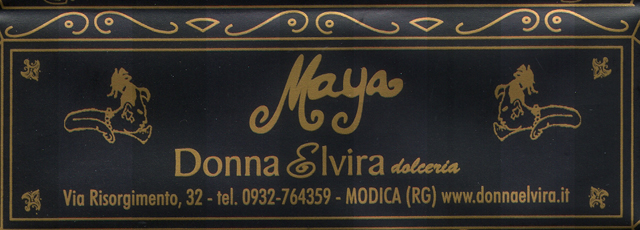Maya
by Donna Elvira
Impact
What ‘Maya’ has to do with “Arriba” might just be another historical mystery. Perhaps the Mayan 'male-bird' Xib'um once flew some Ecuadorian Nacional seeds up to Mesoamerica to transplant them there. Then again, insiders insist good ‘Italian’ olive oil is really Spanish... relabeled.
In the ‘Cioccolato di Modica’ style – very rough & crude (or rustic & simple, depending on POV), based on "traditional" (RE: mythical) Aztec methods, spuriously handed-down to Sicilians by the Spanish in the 16th century who were then conquering what is now Mexico.
The old-school way calls for cocoa, maybe spices - vanilla, chili, or cinnamon - & definitely lots of sugar (the latter two nowhere to be found in the pre-Columbian New World), then laid out on a lava stone, heated slowly by charcoal, & finally worked into shape with rolling pins.
Talk of cold-pressed, & untouched by modern machinery, is pure hype nowadays, as most of these Sicilian makers simply re-melt couverture purchased from giant chocolate companies, adding more sugar to the mixture (the reason why almost all are in the semi-sweet to very sweet range). The amalgam is heated enough for cacáo butter to melt (roughly 95ºF) but not enough to dissolve the sugar crystals.
And sugar is what this is really about.
In the ‘Cioccolato di Modica’ style – very rough & crude (or rustic & simple, depending on POV), based on "traditional" (RE: mythical) Aztec methods, spuriously handed-down to Sicilians by the Spanish in the 16th century who were then conquering what is now Mexico.
The old-school way calls for cocoa, maybe spices - vanilla, chili, or cinnamon - & definitely lots of sugar (the latter two nowhere to be found in the pre-Columbian New World), then laid out on a lava stone, heated slowly by charcoal, & finally worked into shape with rolling pins.
Talk of cold-pressed, & untouched by modern machinery, is pure hype nowadays, as most of these Sicilian makers simply re-melt couverture purchased from giant chocolate companies, adding more sugar to the mixture (the reason why almost all are in the semi-sweet to very sweet range). The amalgam is heated enough for cacáo butter to melt (roughly 95ºF) but not enough to dissolve the sugar crystals.
And sugar is what this is really about.
Appearance 4.3 / 5
a monition & ugly thing of beauty
a monition & ugly thing of beauty
| Color: | polychromatic: pewter, rust, iron |
| Surface: | raw slab |
| Temper: | intentional bloom & rust |
| Snap: | coarse in every way |
Aroma 9.2 / 10
rare: blue stone, celery root, grass, & licorice
Mouthfeel 12.4 / 15
| Texture: | granular |
| Melt: | crumbles along until powder dissolves into micro-remains |
Flavor 35.1 / 50
brown sugar -> molasses -> licorice -> chicosapote -> wintergreen -> hits pavement -> ground cocoa -> iron slag
Quality 14.6 / 20
Chocolate-coated sugar cube. Made with muscovado, a brown sugar produced in The Philippines from extracted cane juice evaporated into a sticky mass retaining its molasses component (hence the dark color), imparting all those licorice flavors.
ING: cocoa mass, muscovado sugar
Reviewed Autumn 2009
ING: cocoa mass, muscovado sugar
Reviewed Autumn 2009




